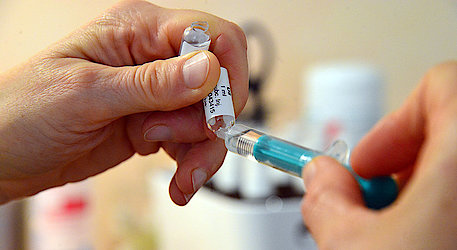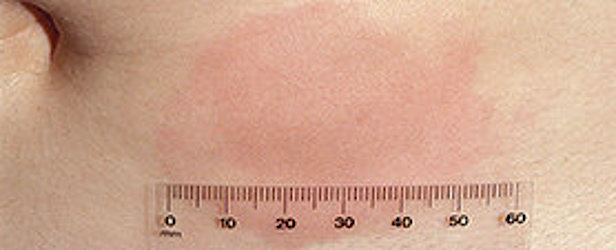Injection under the skin
Anthroposophical mistletoe preparations are injected two to three times a week under the skin (medically: subcutaneous, abbr. s.c.), initially in a low dose. This is increased until a local reaction in terms of a reddening of the skin can be seen. This local reaction resembles a desired side effect – it indicates the reaction of the immune system to the mistletoe.
However, the redness should not be larger than five centimetres in diameter. If it reaches a larger size, you should consult your doctor – the dose may then be too high.
It is normal for the local reaction to decrease during the course of therapy. It may also be absent completely without this indicating an ineffective therapy. In any case, you should inform your doctor about the local reaction and its alteration. It can recur or increase after a change of the preparation or the host tree.

The first injection should be given in the doctor's practise where the treating physician will explain how and where to inject the mistletoe extract and what elso you need to consider. The needles used to inject the mistletoe extract are very fine – the prick when pricking the needle is hardly noticeable.

After injection, the skin reddens around the injection site and usually may swell slightly or possibly itch. This is not an undesirable reaction, but a desired one –- it indicates that the immune system is responding. However, the redness should not be larger than approx. 5 cm – otherwise the dose may be too high.
The abdominal region can be divided into four quadrants. The easiest way is to inject the mistletoe extract alternately into one of the skin fields, where there is usually enough subcutaneous fatty tissue. The thigh is the preferred place for very slim people. However, you should not inject into the same place, because this can irritate the skin too much.
You should warm the ampoules briefly in your hand after removing them from the refrigerator. Then break the glass ampoule at the intended position on the tapered end of the ampoule neck. The syringe can be easily filled with the contents through the opening.
To remove the absorbed air, hold the syringe vertically upwards and slowly push the plunger towards the needle until a drop of liquid emerges. In this case it can be assumed that there is no more air in the cannula.
It is best to practice drawing up the syringe under supervision first. If you have an aversion to giving yourself a syringe, you can ask your partner or someone else to do it.
Before injection, disinfect the injection site with a cellulose swab with a little alcohol. Then use one hand to compress the skin slightly to form a fold, the other hand to place the cannula at an angle of about 45 degrees to the skin surface and slide it into the skin. Since the needle is very fine and short, this process is almost painless. Then slowly press the contents of the ampoule with the plunger into the skin fold. Then pull out the needle.
It is best to collect the used cannulas and ampoules childproof in a commercially available syringe container or an old jam glass with a screw cap and then to dispose of it with your household waste.
Please note: Each syringe and cannula can only be used once. Each injection must be newly drawn up and fitted with a new needle.
Last update: December 18, 2020/ AT
